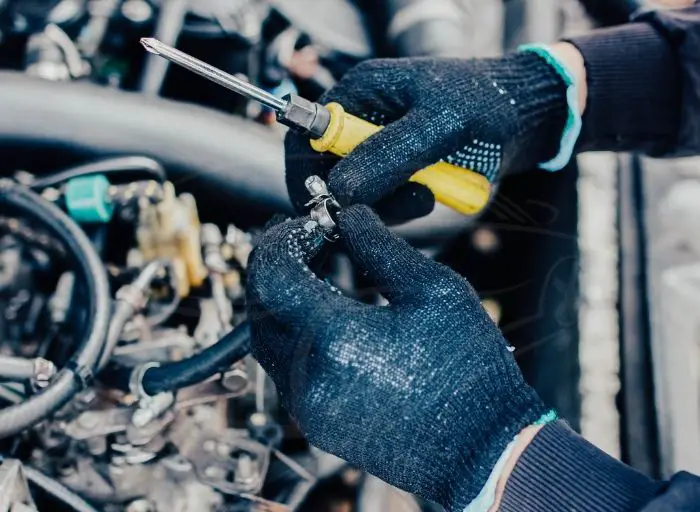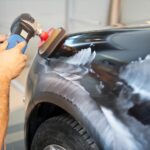
If you’re wondering what air in fuel system symptoms is, don’t worry. I’ll show you a few tell-tale signs that illustrate the seriousness of this problem. This blog post will help you understand what the symptoms are and how to identify whether or not your vehicle is suffering from the air in fuel system problems.
The quick answer:
Air in fuel system symptoms varies, depending on the gasoline or diesel engine type. Your engine may experience low power, misfiring, or vibration.
Table of Contents
Air in Fuel System Symptoms in Gasoline Engines
Gasoline engines commonly experience the following:
- Sputtering and backfiring: The misfiring and low-power symptoms can be caused by air in the fuel system, which creates a leaner fuel or air mixture that results in more backfiring. These happen because the fuel and air mix is not balanced with enough fuel. The backfiring noise occurs due to the explosion caused by the misfire.
- Poor throttle response: Fuel and air mixed with too much nitrous oxide (N02) can create poor throttle response by reducing the engine’s ability to deliver power effectively.
Fuel system components can be damaged due to increased high fuel pressure created by increased air moving through the system, but it mainly affects other parts of the vehicle fuel system.
Air in Fuel System Symptoms in Diesel Engines
Diesel engines commonly experience the following:
- Vibration: The high-rotational centrifugal force caused by air in the fuel system can cause a vibration in the engine. Even if the engine is idle, this vibration will occur because of unbalanced fuel and air mixes. Vibration can cause accelerated wear of all fuel system parts, including the fuel filter, injection pump piston and injectors. It can also cause premature wear of engine mounts and driveshafts.
- Poor engine performance: There is a leaner fuel and air mixture caused by air in the fuel system, which in turn causes poor combustion and reduced throttle response. This also results in poor acceleration. Idling can become difficult because of unbalanced fuel and air mixes. The idle quality keeps fluctuating when it should be fixed at one point.
- Engine knock: Diesel engines used in trucks and buses are more susceptible to this problem because of the higher heavy-duty demand for diesel engines. When air enters the diesel fuel line, it can cause detonation. If this happens, the engine’s performance is reduced because of poor combustion and reduced throttle response.
- Oil consumption: There is more air in the diesel engine than in the gasoline engine, which causes increased air pressure that compresses oil (oil is slippery). This causes oil consumption that is caused by damaged fuel system components.
What Causes Air Getting into The Fuel Supply System?
There are a few things that can cause the air in the fuel system:
1. Engine oil leaks

If there is a leak in the engine oil system, it can allow air to get into the fuel system. The high pressure of the leak will cause pressure build-up in the other parts of the fuel system. If you hear an unusual noise coming from your engine, such as metallic noises and banging noises coming from your engine, this means that there is a leak.
Why does this happen? The turbocharger frequently receives high-pressure flammable gases. These gases are pressurized to improve the engine’s power. If the engine oil becomes contaminated or dilutes, it can result in poor sealing of the gaskets creating excess oil leakage and clogged fuel filter.
2. Fuel leaks

Diesel engines are more susceptible to fuel leaks because of their nature. Diesel engines are frequently used in trucks and buses, which are subjected to frequent bumps and vibrations during transportation. This puts extra pressure on the engine’s fuel system, which can cause leaks in the lines, fuel hose, and seals.
Air can also come from a cracked or damaged air bubble in a fuel line. This is a common problem among vehicles with electronic fuel injection systems.
3. Refueling
Air can enter the fuel system during refueling. Potential sources for this include bad connections at the gas pump and the scavenging of air from the atmosphere by oxygen sensors or other components that are sensitive to air.
Air can also enter the fuel system when the tank is overfilled, which results in the fuel tank’s sump deformation. This problem can lead to many issues within the fuel system.
How To Bleed Air Out of The Fuel System
The first step you need to take is to start the engine and let it idle for a few minutes. The purpose of this is that the engine’s fuel system components will be heated up by the flow of fuel that will allow them to expand. This expansion occurs because the oxygen content in the air increases as it heats up.
This can remove excess air from the fuel lines and injectors. Do not rev the engine during this process since you will throw a wrench into your entire system.
When the vehicle engine is warm, you can put a wrench on one of the lines or injectors and open it up until you hear a “clack” sound. This means that the line is air-tight and air will not enter it anymore. Repeat this step for all of the lines and injectors of the fuel system.
If this does not work, you need to take the vehicle to a mechanic. If your engine is still plagued by air in the fuel system, you should hire a professional mechanic to inspect the problem. It’s important that you hire someone who has experience working on vehicles like your cars.
Tips to Maintain a Clean Fuel System
If you know how to keep the fuel system clean, it’s less likely that your car will have any trouble related to fuel lines.
1. Inspect the car
Start by thoroughly inspecting your fuel system while driving to measure how it is operating. You should be able to accelerate and vary your speed quickly, and the vehicle should drive smoothly. The mileage and condition of the engine will have an impact on how the car drives.
2. Check the fuel color
If the fuel filter on your car is clear, check the color of the fuel. The vehicle’s fuel system has to be cleansed if the fuel seems to be dark. Open the fuel fill area’s lid to get a whiff of the gasoline. If there is a varnish-like odor, the fuel is poor.
3. Check the gas tank & fuel lines
Check the condition of the gasoline tank and the fuel lines. Moisture will enter if any of the gasoline lines are damaged. Regular gasoline tank use may cause it to rust or become fragile over time.
4. Service fuel injector regularly

Remaining gasoline is permitted in the combustion chambers when an automobile’s engine is started. But as the engine cools, the vaporized gases will condense on every surface of the chamber, including the fuel injector and nozzle. As time goes on, the residue could compromise the fuel injector’s efficiency and limit its ability to fuel the engine.
Due to the engine’s cooling and heating cycles, impurities might accumulate on injectors. As a result, cleaning them will be much more difficult and time-consuming.
It’s not fully preventable, but it’s a good idea to let the engine cool before shutting it off if it’s been working particularly hard (due to high temperatures or a lot of uphill driving). Also, driving more carefully at the end of a trip might help extend the injector’s life.
FAQs
#1 What happens if you get air in fuel system?
Rough idling is one of the most common symptoms of air in the fuel system. This occurs when the engine struggles to maintain a consistent idle speed, causing it to surge intermittently and stall. Additionally, acceleration may be sluggish, and the engine may lose power when driving uphill or at higher speeds.
If air has infiltrated the fuel system, the fuel pump may be unable to suck up fuel from the tank since air is lighter than fuel and will bubble up to the top. This can cause the engine to seize up, as the fuel pump struggles to deliver enough fuel to keep the engine running.
If the air enters the fuel injectors, it can cause them to overheat and wear out prematurely. It can also cause them to clog, which will reduce fuel efficiency and engine performance.
#2 Will air in fuel line go away by itself?
Air in a fuel line can dissipate on its own, depending on the situation. If the air is trapped in the fuel line due to a temporary disruption in fuel flow, such as during refueling or due to a malfunctioning fuel pump, it may naturally rise to the top and escape, allowing the fuel to flow freely again. In such cases, the air bubbles will usually be displaced by the incoming fuel and be purged through the fuel system.
However, if the air is continuously entering the fuel line due to a persistent issue such as a leak or an air intake problem, it may not go away on its own and may require attention. Air in the fuel line can cause various problems, such as reduced fuel efficiency, poor engine performance, and even engine damage if not addressed promptly.
#3 How can I fix the air in my vehicle’s fuel line?
You’ll want to find the bleed screw to remove the air from the line. This is typically located near the fuel pump. Loosen the screw with a wrench, and then turn on the engine. Fuel should begin to come out of the bleed screw.
Allow the fuel to continue flowing out of the bleed screw until no more air bubbles are present. This may take a few minutes.
Once all the air has been removed, tighten the bleed screw with your wrench. Be careful not to overtighten it.
#4 What happens if there is too much air and not enough fuel?
If there is an excessive amount of air and not enough fuel in the fuel mixture being supplied to an engine, it can result in several issues, such as:
- Poor combustion
- Reduced power and performance
- Engine misfire
- Overheating
- Increased emissions
#5 What happens if I don’t fix air in the fuel system?
- Reduced performance and power output
- Stalling or difficulty starting the engine
- Poor fuel economy due to excessive fuel consumption
- Increased emissions which can harm the environment
- Damage to expensive components such as injectors, fuel pumps and other related parts.
#6 Can I drive with air in the fuel system?
Final Words
When you see any of the symptoms mentioned above, your car engine is plagued by air in the fuel system, try to fix it if you can, or you can take it to a reputable mechanic. The best thing you can do is prevent the problem by doing a good service maintenance period. Make sure that all of your fuel system components are sealed and not leaking, especially the gaskets holding them together.
Further Reading:
Hi there! I’m Naomi O’Colman. I’ve got years of experience working at an auto repair shop here in Texas under my belt. On top of that, ever since I was a kid I’ve been passionate about the auto industry. Since I’ve joined the team at automotivegearz.com I’ve been enthusiastically sharing my passion and insights with my readers. I’m dedicated to delivering high quality content and helping you stay up to date with the latest automotive trends and products out there!







